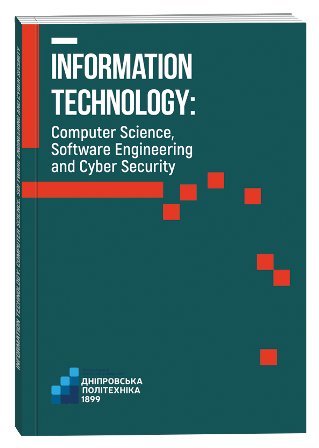NEURAL NETWORK APPROACH TO DETECTING WATER OBJECTS IN MULTISPECTRAL IMAGES
DOI:
https://doi.org/10.32782/IT/2024-4-16Keywords:
convolutional neural networks, semantic segmentation, satellite imagery, water resources, environmental monitoring.Abstract
Aim of the Study. The goal of this research is to develop and implement an effective neural network approach based on the U-Net model for detecting structural elements of Ukraine’s aquatic environment through the analysis of multispectral images from the Sentinel-2 satellite. This entails enhancing both accuracy and speed in identifying changes in water bodies and ecological network components, thereby enabling prompt responses to environmental challenges. Methodology. An automatic approach to forming the training set is utilized, relying on the Normalized Difference Water Index (NDWI). Binary water masks are generated based on a threshold value applied to the Sentinel-2 green and near-infrared channels, enabling the creation of a large training dataset without manual labeling. The model is built around the U-Net architecture: the encoder extracts high-level features, while the decoder restores spatial resolution and produces the segmentation map. During training, a combined loss function that merges binary cross-entropy with the Dice coefficient is applied. Model evaluation uses F1 score, precision, recall, and Intersection over Union (IoU). Testing the model on full-resolution images of different areas demonstrates a high degree of generalization. Scientific Novelty. The proposed approach integrates automatic generation of water body masks (via NDWI) with a U-Net-based architecture tailored for binary segmentation of large satellite images. This integration eliminates the need for manual labeling and ensures accurate water detection results. The use of a combined loss function improves the model’s sensitivity to fine water structures, while experiments under various imaging conditions confirm its robustness against spectral and atmospheric variability. Conclusions. An effective model has been developed for the segmentation of water bodies in Sentinel-2 satellite images using a deep neural network with a U-Net architecture. The process involved data preparation, wherein water masks were automatically generated based on the NDWI index, followed by thorough training of the model with a combined loss function that merges binary cross-entropy and the Dice coefficient. The model achieved high accuracy metrics, confirmed by an F1 score of 0.8897, precision of 0.8721, recall of 0.9080, and an IoU of 0.8013, demonstrating its capability for accurately detecting water bodies of various sizes and shapes.The advantages of the chosen approaches stem from combining deep learning with prior data processing, which automated the detection of water bodies and ensured high segmentation accuracy. The model exhibits flexibility, scalability, and computational efficiency, making it suitable for practical applications in water resource monitoring and environmental studies. Future research directions include experimenting with different neural network architectures, employing alternative methods for mask generation, and incorporating spatiotemporal information to further enhance the model’s effectiveness and versatility.
References
IPCC. Climate Change 2021: The Physical Science Basis. URL: https://www.ipcc.ch/report/ar6/wg1/
United Nations Environment Programme (UNEP). Environmental Issues Emerging from Conflict and Disaster. 2021. URL: https://www.unep.org/explore-topics/disasters-conflicts
Li W., Fu H., Yu L., Cracknell A. Deep learning based oil spill detection from polarimetric SAR data. Remote Sensing of Environment, 2019. 233, 111368. URL: https://www.sciencedirect.com/science/article/pii/S0034425719304563
Ma L., Liu Y., Zhang X., Ye Y., Yin G., Johnson B. A. Deep learning in remote sensing applications: A meta-analysis and review. ISPRS Journal of Photogrammetry and Remote Sensing, 2019. 152, 166–177. URL: https://www.sciencedirect.com/science/article/pii/S0924271618303333
Zhang C., Liu F., & Li W. A review of remote sensing image classification techniques: the role of spatiocontextual information. European Journal of Remote Sensing, (2020). 53(1), 176–197. URL: https://www.tandfonline.com/doi/full/10.1080/22797254.2020.1727854
Li W., Fu H., Yu L., Cracknell A. Deep learning based oil spill detection from polarimetric SAR data. Remote Sensing of Environment, 2019. 233, 111368. https://doi.org/10.1016/j.rse.2019.111368
Gao B., Huang J., Li J., Chen Z. Detecting algal blooms in coastal waters using deep learning and satellite imagery. Remote Sensing, 2020. 12(7), 1135. https://doi.org/10.3390/rs12071135
Zhang C., Li W., Travis D. Gaps fill of land cover classification with deep learning. Remote Sensing of Environment, 2021. 267, 112716. https://doi.org/10.1016/j.rse.2021.112716
Chen Y., Jiang H., Li C., Jia X., Ghamisi P. Deep feature extraction and classification of hyperspectral images based on convolutional neural networks. IEEE Transactions on Geoscience and Remote Sensing, 2021. 59(7), 5899–5921. https://doi.org/10.1109/TGRS.2020.3028704
Santurkar S., Tsipras D., Ilyas A., Madry A. How Does Batch Normalization Help Optimization?Advances in Neural Information Processing Systems, 2018. 31, 2483–2493. URL: https://proceedings.neurips.cc/paper/2018/file/905056c1f1abf51a8521faa9756a31d8-Paper.pdf
Duan W., He B., Nover D., Yang G., Chen W., Meng H., Liu C. Water bodies’ mapping from Sentinel-2 imagery with modified normalized difference water index at 10-m spatial resolution produced by sharpening the SWIR band. Remote Sensing, 2019. 11(23), 2779. https://doi.org/10.3390/rs11232779
Zhou Z., Siddiquee M.M.R., Tajbakhsh N., Liang J. UNet++: Redesigning skip connections to exploit multiscale features in image segmentation. IEEE Transactions on Medical Imaging, 2019. 39(6), 1856–1867. https://doi.org/10.1109/TMI.2019.2959609
Ramachandran P., Zoph B., Le Q. V. Searching for activation functions. arXiv preprint arXiv:1710.05941. 2018. URL: https://arxiv.org/abs/1710.05941
Ioffe S., Szegedy C. Batch normalization: Accelerating deep network training by reducing internal covariate shift. Proceedings of the 32nd International Conference on Machine Learning, 2015. 37, 448–456. http://proceedings.mlr.press/v37/ioffe15.html
Yeung M., Sala E., Schönlieb C. B., Rundo, L. Unified focal loss: Generalising Dice and cross entropybased losses to handle class imbalanced medical image segmentation. Computerized Medical Imaging and Graphics, 2021. 89, 101885. https://doi.org/10.1016/j.compmedimag.2021.101885
Li X., Chen H., Qi X., Dou Q., Fu C. W., Heng P. A. H-DenseUNet: Hybrid Densely Connected UNet for Liver and Tumor Segmentation From CT Volumes. IEEE Transactions on Medical Imaging, 2018. 37(12), 2663–2674. https://doi.org/10.1109/TMI.2018.2845918
Luo L., Xiong Y., Liu Y., Sun X. Adaptive gradient methods with dynamic bound of learning rate. Proceedings of the 7th International Conference on Learning Representations (ICLR). 2019. URL: https://arxiv.org/abs/1902.09843
Buda M., Maki A., Mazurowski M. A. A systematic study of the class imbalance problem in convolutional neural networks. Neural Networks, 2018. 106, 249–259. https://doi.org/10.1016/j.neunet.2018.07.011
Prechelt L. Early stopping – but when?. In Neural Networks: Tricks of the Trade (2012). (pp. 53–67). Springer. https://doi.org/10.1007/978-3-642-35289-8_5
Smith L. N. A disciplined approach to neural network hyper-parameters: Part 1 – learning rate, batch size, momentum, and weight decay. arXiv preprint arXiv:1803.09820. 2018. URL: https://arxiv.org/abs/1803.09820
Yang P., Zhang L., Zhao W., Xie X. Retinal vessel segmentation using a U-Net based convolutional neural network. Symmetry, 2020. 12(4), 611. https://doi.org/10.3390/sym12040611
Rahman M. A., Wang Y. Optimizing intersection-over-union in deep neural networks for image segmentation. In International Symposium on Visual Computing (2016). (pp. 234–244). Springer. https://doi.org/10.1007/978-3-319-50835-1_22
Liu X., Song L., Liu S., Zhang Y. A review of deep-learning-based medical image segmentation methods. Sustainability, 2019. 11(7), 1897. https://doi.org/10.3390/su11071897
Li B., Liu Y., Wang Y., Li M., Liu Y. A comparison of clustering algorithms for water body extraction from remote sensing images. Remote Sensing, 2020. 12(10), 1590. https://doi.org/10.3390/rs12101590
Duan W., He B., Nover D., Yang G., Chen W., Meng H., Liu C. Water bodies’ mapping from Sentinel-2 imagery with modified normalized difference water index at 10-m spatial resolution produced by sharpening the SWIR band. Remote Sensing, 2019. 11(23), 2779. https://doi.org/10.3390/rs11232779
Zhou Z., Siddiquee M.M.R., Tajbakhsh N., Liang J. UNet++: A Nested U-Net Architecture for Medical Image Segmentation. In Deep Learning in Medical Image Analysis and Multimodal Learning for Clinical Decision Support 2018. (pp. 3–11). Springer. https://doi.org/10.1007/978-3-030-00889-5_1
Oktay O., Schlemper J., Le Folgoc L., Lee M., Heinrich M., Misawa K., … Rueckert D. Attention U-Net: Learning Where to Look for the Pancreas. arXiv preprint arXiv:1804.03999. 2018. URL: https://arxiv.org/abs/1804.03999
Chen L. C., Zhu Y., Papandreou G., Schroff F., Adam H. Encoder-Decoder with Atrous Separable Convolution for Semantic Image Segmentation. In Proceedings of the European Conference on Computer Vision (ECCV) 2018. (pp. 801–818). https://doi.org/10.1007/978-3-030-01234-2_49
Olena Dobrovolska, Knut Schmidtke, Viktoriia Hnatushenko, Svitlana Sytnyk and Iryna Dmytriieva Relationship between economic development, forest resources, and forest fires: European context. Environmental Economics, 2024. 15(2), 77–92. doi:10.21511/ee.15(2).2024.06.
Hnatushenko V. V, Mozgovoy D. K., HnatushenkoVik. V., Spirintsev V. V., Udovyk I. M. All-weather monitoring of oil and gas production areasusingsatellite data//Scientific bulletin of National Mining University. State Higher Educational Institution “National Mining University”, Dnipro, 2019. № 6 (158). С. 99–105.







